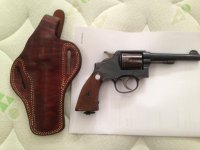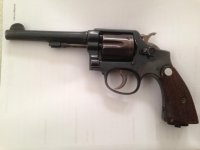You are using an out of date browser. It may not display this or other websites correctly.
You should upgrade or use an alternative browser.
You should upgrade or use an alternative browser.
Smith & Wesson help needed
- Thread starter Slippers
- Start date
Mike Irwin
Staff
Assuming that it's .38 Special, it appears to be a run of the milll war time Military & Police Hand Ejector, or pre Model 10 as it is commonly known.
It appears, however, that the cylinder is a replacement.
In order for anyone to give you more information, you'll need to describe any markings that you might find on the gun.
It appears, however, that the cylinder is a replacement.
In order for anyone to give you more information, you'll need to describe any markings that you might find on the gun.
carguychris
New member
I think the barrel is a 5-incher, which suggests that the gun may be an .38/200 British Service Revolver aka "British Victory" produced for the British military early in WWII when S&W was still finishing these guns in a glossy rust blue rather than grey-black matte phosphate. The lanyard loop usually indicates a military gun.
Other hallmarks of such a gun will be a *.38 S&W CTG.* (rather than *.38 S&W SPECIAL CTG.*) barrel rollmark, numerous small crown-over-BNP proof marks, and a serial number in the high six-digit range with no alphabetical prefix. S&W added a "V" prefix when production numbers surpassed 1 million, but most of these guns have the aforementioned matte phosphate finish.
On a S&W of this vintage, the serial number*- or at least the last several digits- should be repeated on the cylinder face and on the barrel flat over the ejector rod. Differing numbers in these places indicate replacement parts.
In addition to the cylinder, I think the stocks (grips) may be replacements from a different gun, because they don't appear to have a factory-perfect fit at the top of each panel around the medallions. Until the 1970s, S&W stocks were shaped to fit individual guns, and the fit was usually almost seamless.
[*Edit to add footnote: The serial number on a medium-frame S&W swing-out cylinder revolver is found on the butt. The number inside the yoke cut in the frame is normally a meaningless assembly number.]
Other hallmarks of such a gun will be a *.38 S&W CTG.* (rather than *.38 S&W SPECIAL CTG.*) barrel rollmark, numerous small crown-over-BNP proof marks, and a serial number in the high six-digit range with no alphabetical prefix. S&W added a "V" prefix when production numbers surpassed 1 million, but most of these guns have the aforementioned matte phosphate finish.
Agreed, perhaps to allow .38 Special ammo to be fired. The British guns were almost all chambered in .38 S&W, a shorter, slightly larger-caliber, and less powerful cartridge that fell out of favor in the postwar era.It appears, however, that the cylinder is a replacement.
On a S&W of this vintage, the serial number*- or at least the last several digits- should be repeated on the cylinder face and on the barrel flat over the ejector rod. Differing numbers in these places indicate replacement parts.
In addition to the cylinder, I think the stocks (grips) may be replacements from a different gun, because they don't appear to have a factory-perfect fit at the top of each panel around the medallions. Until the 1970s, S&W stocks were shaped to fit individual guns, and the fit was usually almost seamless.
[*Edit to add footnote: The serial number on a medium-frame S&W swing-out cylinder revolver is found on the butt. The number inside the yoke cut in the frame is normally a meaningless assembly number.]
carguychris
New member
One other thing...
A comment about model numbers for the uninitiated...
Collectors often use the term "pre-Model" to refer to pre-1957 guns that are similar to a later numbered model.
A comment about model numbers for the uninitiated...
Prior to 1957, S&W swing-out cylinder revolvers had names rather than model numbers. This makes things confusing for novices because the model name was normally only marked on 2 models- the .38 Regulation Police and the .357 Highway Patrolman. For all the others, unless you have the original box or owner's manual- which is seldom the case- the model name must be determined by correlating the frame size, the cartridge it fires, and sometimes other features....pre Model 10 as it is commonly known.
Collectors often use the term "pre-Model" to refer to pre-1957 guns that are similar to a later numbered model.


